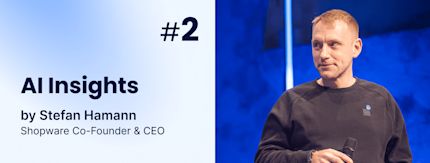
A quick scene-setter
In the previous edition, I argued that the classic ecommerce funnel has now shrunk to the length of a coffee blink. ChatGPT’s upgraded search, married to automated agentic payment, can move a shopper from first query to paid receipt in about half a second.
That post: “AI is eating ecommerce for breakfast – Agentic Commerce just took the first bite”, raised an uncomfortable question: If an autonomous agent can’t spot anything truly unique about your store, why would it ever stop scrolling?
n keeping with this, ecommerce strategist Stan Sidorenko published a meticulous field test of ChatGPT’s new Shopping Assistant. He traces every wire: Bing index, structured feeds and review signals.
Think of it as one blueprint: my big-picture radar meets Stan’s nuts-and-bolts toolkit. Scroll down to see that hybrid, distilled into action steps you can ship before the first stand-up.
1. Last week – the 30-second recap
In my post last week I argued that ecommerce just lost its leisurely, multi-click journey. With ChatGPT’s upgraded search stacking live product data on top of new agentic payment solutions, discovery and checkout now happen in the same half-second reasoning burst. The old funnel is gone; what’s left is a single “thought-chain” the model runs once before money changes hands.
Key take–aways in bullet–time
500 ms funnel – Awareness → consideration → payment collapses into one LLM inference.
Agent first, human later – A bot vets specs, price, stock and SLAs before any pixels reach the shopper.
Uniqueness is the new ranking factor – If your data, service promise or brand story can be copy-pasted, the agent treats you as a commodity line in its JSON feed.
Execution-Engine Optimisation (EEO) beats SEO – Endpoints like /api/agent/buy and live logistics feeds outrank keyword density and banner polish.
Stress-test the P&L – Plan for up to 50 % less organic traffic and thinner margins once agents steer commodity spend to the cheapest compliant vendor.
2. What Stan's field test confirms
Stan´s teardown of ChatGPT’s new Shopping Assistant shows where the model pulls its facts, how it sorts them, and why the very first click could also be the last.
The table below distils those findings into a side-by-side snapshot:
Table 1 – Field-test takeaways
What the test uncovered | Why it matters |
|---|---|
Data sources – web index, structured merchant feed, public reviews | robots.txt and feed hygiene move from housekeeping to ranking factors |
Ranking signals – clean schema, "best/top/how-to" listicles, price + friction metrics | Content still wins - if a model can parse it in milliseconds |
Payment rails – one-click / embedded-checkout APIs | When checkout is zero-or-one click, the first human interaction may be after the order is placed |
3. From insight to next-sprint commits
Knowing how the Assistant works only matters if we translate it into tasks we can start working towards the future of commerce. Below is the connector between theory and practice: each insight on the left, the core principle in the middle, and the very first move on the right.
Table 2 – Monday-morning action sheet
Assistant insights | Agentic principle | First action item |
|---|---|---|
Bots crawl via web search & OAI-SearchBot | Unique data wins | Publish a public JSON feed: live stock, delivery SLA, return–rate |
"Best/top/how–to" listicles seed answers | Stories still sell | Pitch your hero use-case to high-authority sites; become the cited example |
One-click payment rails collapse checkout | Funnel keeps shrinking | Expose agent-compatible purchase endpoints; test zero-UI orders |
Lock the feed, pitch the story, wire the endpoint – then polish the banners if you still have time.
4. Three working bets for 2025–26
“Nothing is as powerful as human convenience.”
Convenience, as Evan Williams reminds us, is the web’s prime accelerant: remove steps and you win . That same force will reshape traffic patterns, margin models and feature roadmaps over the next 12 months. Below are three trends with enough early evidence to warrant a line item in the 2025 budget:
EEO eclipses SEO
Organic–traffic volatility (-20 % to -30 % by mid-2026)
Experience becomes a data object
Use these three guard-rails when setting capacity, marketing spend and product cadence for 2025–26. They will keep the roadmap honest without drifting into science fiction.
5. Why this matters – even if acronyms make your eyes glaze over
The shopper’s first impression increasingly happens inside a chat window you don’t control. Your storefront must be machine–readable and human– memorable at the same time. Stan’s article diagrams the pipes; our Agentic Commerce white paper explains the principles. Together they give you a survival–and growth–kit for the half–second economy.
Stay curious, keep shipping. 🧑🚀🛒
– Stefan

You might also be interested in:
Learn more about Shopware and Artificial Intelligence
Download the Agentic Commerce white paper
Learn why AI is eating ecommerce for breakfirst











